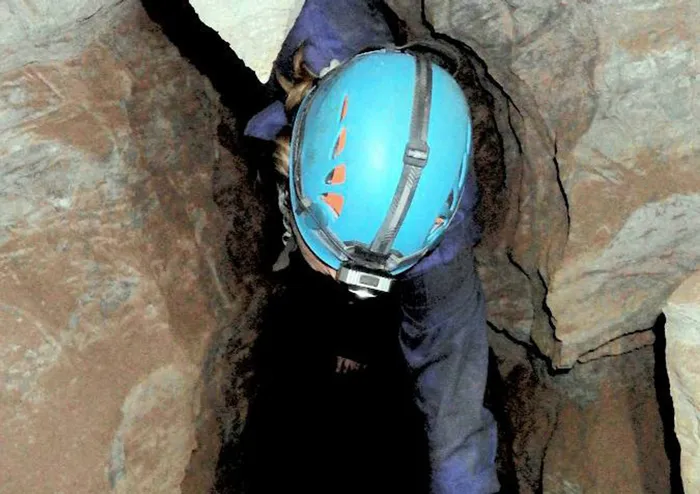Descending into the belly of the beast

TIGHT SPOT: Marina Elliott works in a constricted area of the Rising Star cave. Photo: Elen Feuerriegel TIGHT SPOT: Marina Elliott works in a constricted area of the Rising Star cave. Photo: Elen Feuerriegel
IT WAS like looking into a shark’s mouth – with its sharp teeth – only it wasn’t a shark, but a cave chamber with sharp rock edges
and a chute so narrow that experienced excavator Marina Elliott doubted her decision to travel from Canada to the Cradle of Humankind almost two years ago to be part of the team to recover the fossil hominin find.
The 46-year-old was the first of six women selected as “underground astronauts” to go down the narrow hamber.
The women who went down the chamber were girded with an overall, hiking boots and a battery pack attached to a light mounted on a caving helmet, and gloves. They were working in
tight corners, so the less gear to weigh them down or obstruct their climb, the better. For the first round of excavations, Elliott went down with archaeologists Becca Peixotto and Hannah Morris. “It’s a technical climb, so there’s a big crack essentially.
If you have your back against the rock, you can still touch the rock with your chest. If you inhale as hard as you can, you can hold yourself on either side of the rock with no hands,” she said. “Fortunately, because of how convoluted the area is, you can’t fall hard, but you can fall sharp. We got very bruised and battered daily.” The excavators would spend five or six hours
a day excavating on their hands and knees, which, Elliott admitted, was hard on the body. “The actual excavation is reasonably
straightforward if you’re an archaeologist because this material was in soft sediment (mud and clay), so we’d excavate it with things like toothpicks, bamboo skewers and little paint brushes.
For your average person, it’s pretty boring work, but when you get into the groove of it, it’s meditative,” Elliott said.
Once a piece was out, it was given a preliminary identification, wrapped, numbered, put into a container then another container, which was put into a waterproof bag and passed up the
chute either by a human chain or a rope system. Then it would be carried to a tent where senior scientists would analyse it.
“We were bringing up, on any given day, 50 to 60 fragments, which is ridiculous. I mean, people in East Africa find two fragments a year,” she said.
The second excavation in March was when some of the “really cool stuff” came out, like the articulated hand, Elliott said.
“The hand was found in a curved position; it was all there… that was like a chill moment.
It was really, really exciting,” she said. Elliott was also part of the group that convened in May last year for a workshop, and along with other scientists, did a description and analysis of the fossils. She is living in South Africa now as a post-op
researcher. “If this inspires any kid to go into science,
I’m happy. To say that it’s cool, human origins are cool, for them to ask the big questions – what an honour.”